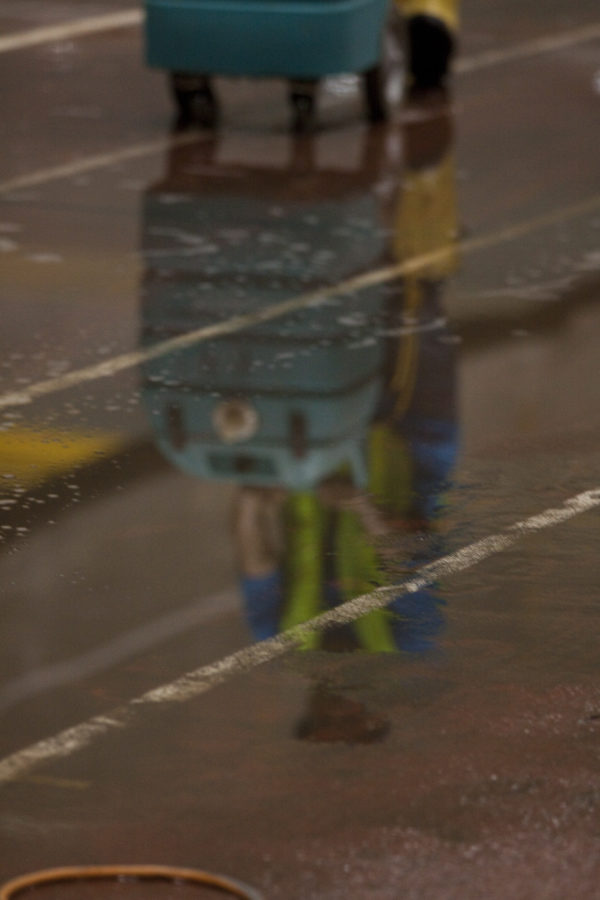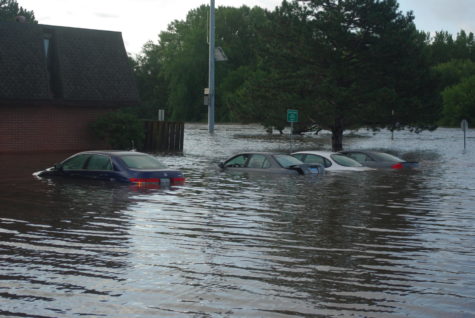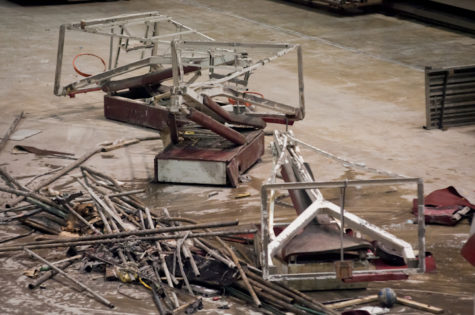Flooding leaves ISU athletics in the dark
Photo: Rebekka Brown/Iowa State Daily
ServiceMaster cleanup crews help to remove the water from the indoor track on Friday, Aug. 13 at the Lied Recreation Athletic Center. Many in season teams are directly impacted by the water damage at Lied and will be forced to find other facilities to practice at.
August 13, 2010
It’s hard to believe that just a few days ago one of the biggest concerns the people of Ames had was how to deal with road construction.
Now? Now it’s hard to find drinkable water.
The old saying goes, “You don’t know what you’ve got till it’s gone.” That couldn’t be more evident today.
Ames and Iowa State are facing the toughest challenge they’ve seen in recent memory. On Wednesday, I arrived in Ames to the utter devastation on University Avenue and around Hilton Coliseum and Jack Trice Stadium.
It was a truly sad sight to see. My feelings echoed that of women’s basketball coach Bill Fennelly, who said, “It’s hard not to cry a little bit.”
And now, days after torrential rains rocked Ames, Iowa State and the Ames community have to regroup and begin to rebuild. How fast it gets done and how much it will cost is anyone’s guess.
As of Thursday afternoon, water inside Hilton Coliseum was approximately 10 feet high, or just below the scoreboards in the corners of the lower level. Hilton staff had four large pumps running, trying to remove water, but with such an amount and only four pumps, there’s no telling how long that will take.
Assistant Athletic Director Nick Britton led various members of the media on a brief look at Hilton on Thursday, and when asked how long he thought it might take to drain the water, he gave an exasperated laugh, shrugged his shoulders and said, “I have no idea.”
That theme — one of uncertainty and doubt — is one common amongst ISU officials. They’re just as confused, frustrated and exhausted as anyone, and maybe more so in some cases.
With the water at its current level, it’s likely that all the offices and locker rooms on the lower levels of Hilton are destroyed. It begs the question: How much will it all cost?
But that’s just one more unanswerable question. Until the water is removed and they can assess the situation, there simply is no way of knowing exactly how much it will end up being.
However, they remain as upbeat as possible. Steve Malchow, senior associate athletic director for communications, was also at the mini-tour of Hilton on Thursday afternoon. He joked that they had wanted to renovate the locker rooms anyway.
But Malchow did stress the gravity of the task ahead. The athletic department has two programs that are immediately affected by the flooding.
The volleyball team has been forced to relocate to West Towne Courts, and the women’s soccer team will have to as well, as their field — along with Lied Recreation Athletic Center — is submerged. Malchow said the immediate worry is where the teams will practice, and they’ll worry about games second. But with ISU soccer having its opener Aug. 20, there is precious little time in which to figure things out.
Looking forward, there is little doubt amongst those within the athletic department that things will be fixed and return to normal. Tailgaters may have to deal with mosquitoes and park in the grass somewhere, but don’t doubt that those who support and love Iowa State will continue to do so.
Until then, it’s up to Mother Nature to decide if more action has to be taken.
It’s times like these when the true character and resiliency of a university and its members come out.
I think Bill Fennelly said it best on Twitter:
“Love this quote–if it truly means something you WILL find a way-if not you will find an excuse. We WILL find a way- NO excuses at Iowa State.”












